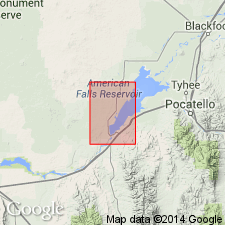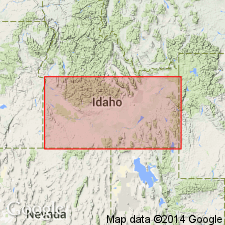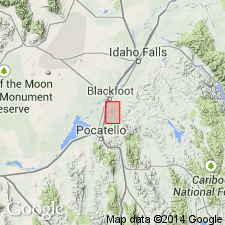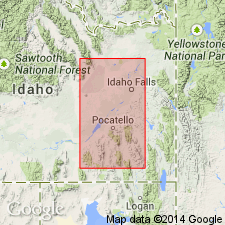
- Usage in publication:
-
- Starlight formation*
- Modifications:
-
- Named
- Dominant lithology:
-
- Tuff
- Basalt
- AAPG geologic province:
-
- Snake River basin
Summary:
Named for Starlight Creek, Arbon quad, Power Co, ID in Snake River basin. Type area designated on Starlight Creek southeast of American Falls. Geologic map included. Divided into lower and upper members separated by a vitric-crystal tuff member. Unconformably rests on Madison? limestone. Unconformably underlies Neeley formation (redefined). Probably is more than 800 ft thick. Lower member consists of white- to gray-bedded, rhyolitic, friable tuff with many interstratified basalt flows, and minor basaltic tuff and breccia. The vitric-crystal tuff member, 10-75 ft thick, is light gray to tan, generally friable in lower part, compact and welded in upper part. The upper member, probably at least 200 ft thick, is mostly white, parallel-bedded rhyolitic friable tuff, but also has pumiceous tuff, breccia, and marl. Also contains vitrophyre, a dark, glassy, porphyritic rock and basalt present in upper and lower members. Fossils (mollusks, diatoms, and camel) found. Assigned to early and middle Pliocene.
Source: GNU records (USGS DDS-6; Denver GNULEX).

- Usage in publication:
-
- Starlight Formation*
- Modifications:
-
- Geochronologic dating
- AAPG geologic province:
-
- Snake River basin
Summary:
Pg. 241. Starlight Formation. Samples from ash flows near American Falls, Power Co., eastern Snake River Plain, southern ID, yielded K-Ar ages of 6.5 and 7.7 Ma; [North American land mammal age Hemphillian; =Pliocene (Evernden and others, 1964, Amer. Jour. Sci., v. 262, p. 145-198), =Miocene (Berggren, 1972, Lethaia, v. 5, no. 2, p. 195-215)]. Underlies Neeley Formation. Report includes sample locality map, schematic stratigraphic-chronologic diagram, table of K-Ar ages.
Source: Publication.

- Usage in publication:
-
- Starlight Formation*
- Modifications:
-
- Geochronologic dating
- AAPG geologic province:
-
- Snake River basin
Summary:
Starlight Formation dated near Blackfoot, Bighorn Co, ID in the Snake River basin. Overlies Eocene andesite; underlies Miocene Walcott Tuff or tuff of Blacktail. Divided into: 1) lower member, which has two dated rhyolites--the rhyolite of Two-and-a-Half-Mile Creek, which has a 9.1 +/-0.3 Ma date (on biotite) and the rhyolite of Stevens Peak, which has a 9.8 +/-0.9 Ma date; 2) middle member, also called tuff of Arbon Valley, which has a 7.7 Ma date and has normal magnetic polarity, and 3) upper member, which has a basalt flow with a 7.0 +/-0.3 Ma date. Age is Miocene.
Source: GNU records (USGS DDS-6; Denver GNULEX).

- Usage in publication:
-
- Starlight Formation*
- Modifications:
-
- Revised
- Geochronologic dating
- AAPG geologic province:
-
- Snake River basin
Summary:
Arbon Valley Tuff Member named (previously called tuff of Arbon Valley by Trimble, Carr, 1976, USGS Bull. 1399). K-Ar and 40Ar/39Ar age determinations on Arbon Valley yield weighted mean age of 10.2 +/-0.06 Ma (tables 1, 2) which is oldest Miocene isotopic age recorded east of Sublette Range along southeastern margin of Snake River Plain. New dates revises stratigraphy of Starlight proposed by Kellogg, Marvin (1988) [compare fig. 6 of this report with fig. 3 of Kellogg, Marvin (1988)]. Now Arbon Valley is placed below rhyolite of Stevens Peak (9.8 Ma) and rhyolite of Two-and-a-Half Mile Creek (9.1 Ma) which were considered part of lower member of Starlight and are now part of upper member. Arbon Valley is younger than rhyolitic ash and rhyolitic waterlain sediments of lower member of Starlight of Trimble, Carr (1976). A rhyolite flow from upper part of Starlight informally named rhyolite of west Pocatello yielded a K-Ar age date of 7.9 Ma. Geochemistry (tables 3, 4; fig. 7). Unconformably overlies Proterozoic and Paleozoic rocks; locally underlies a coarse boulder diamictite, tuff of Blacktail, or Wolcott Tuff. Miocene age.
Source: GNU records (USGS DDS-6; Denver GNULEX).
For more information, please contact Nancy Stamm, Geologic Names Committee Secretary.
Asterisk (*) indicates published by U.S. Geological Survey authors.
"No current usage" (†) implies that a name has been abandoned or has fallen into disuse. Former usage and, if known, replacement name given in parentheses ( ).
Slash (/) indicates name conflicts with nomenclatural guidelines (CSN, 1933; ACSN, 1961, 1970; NACSN, 1983, 2005, 2021). May be explained within brackets ([ ]).

